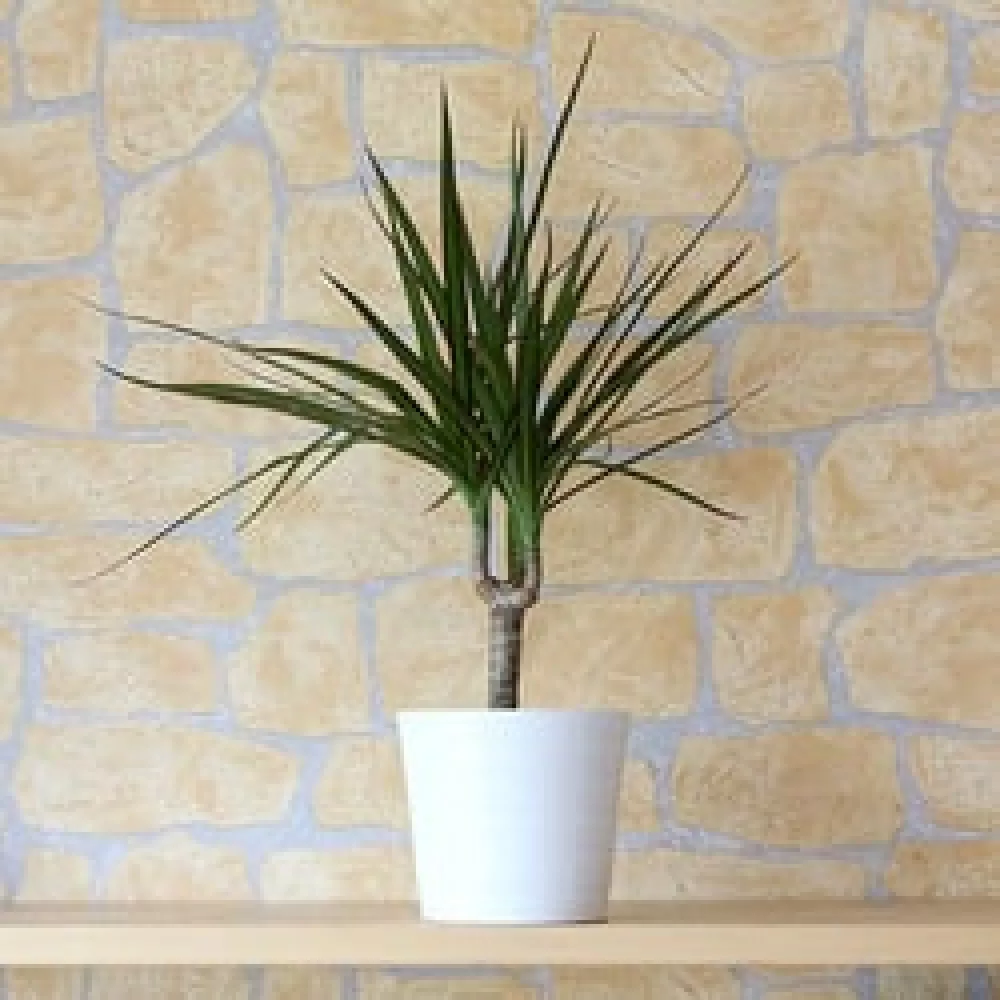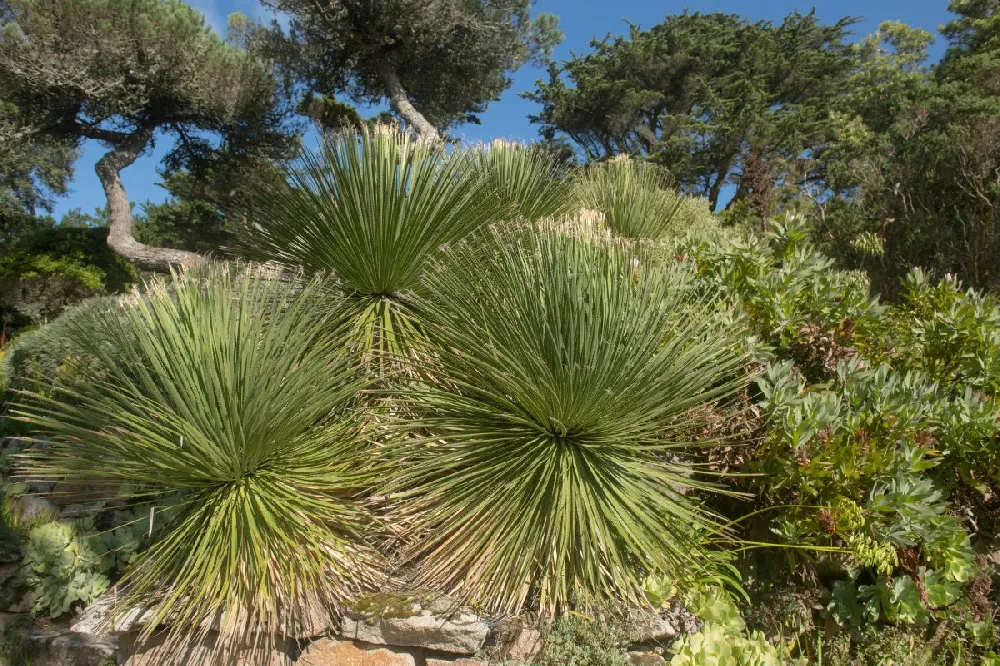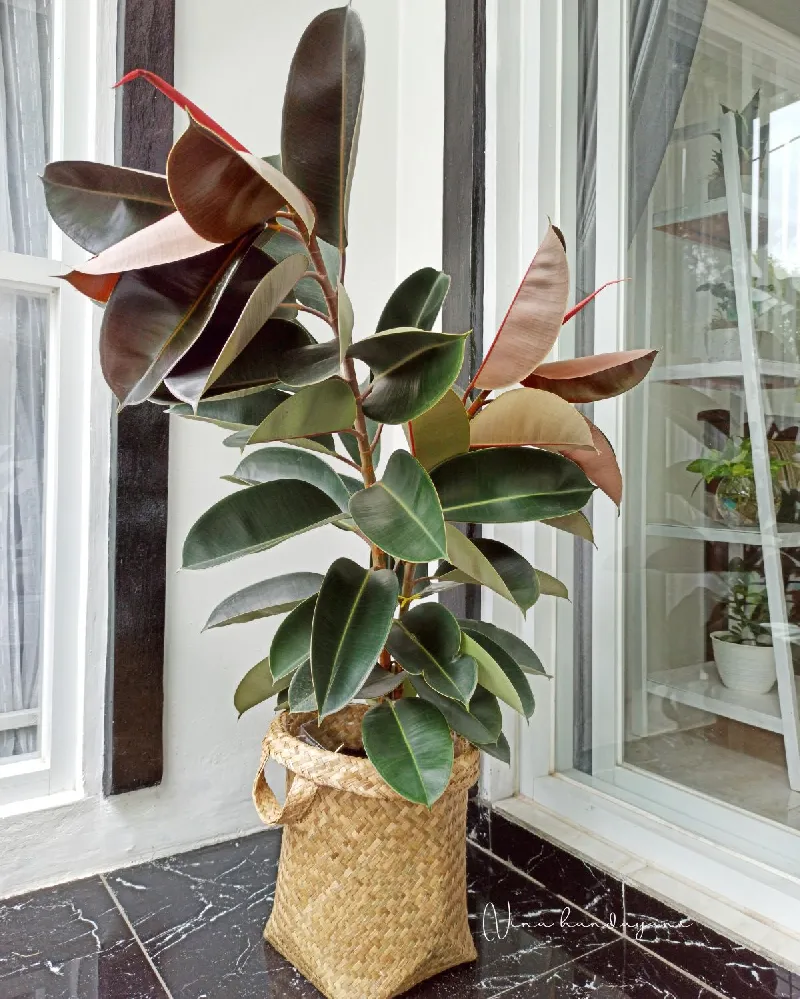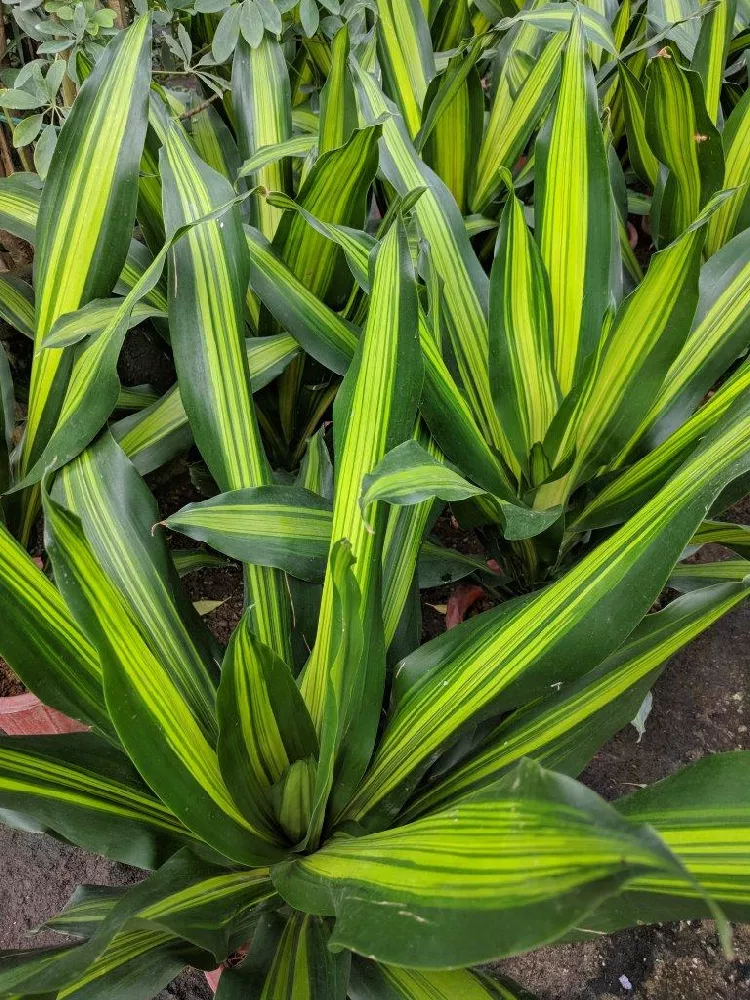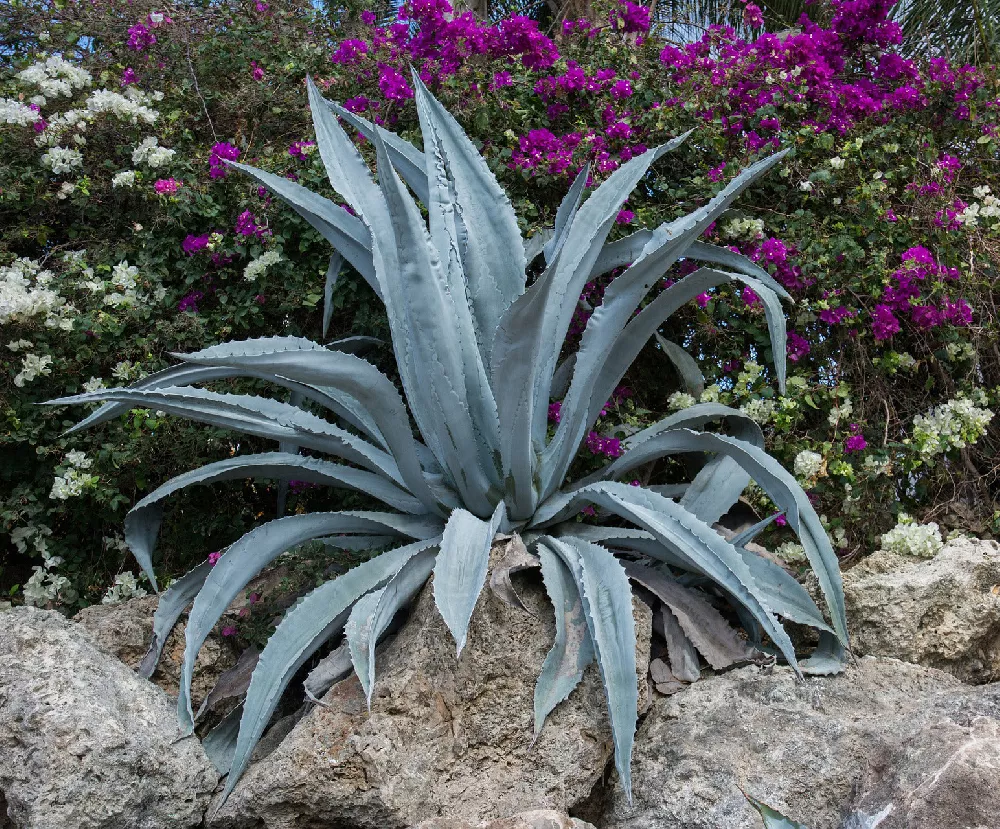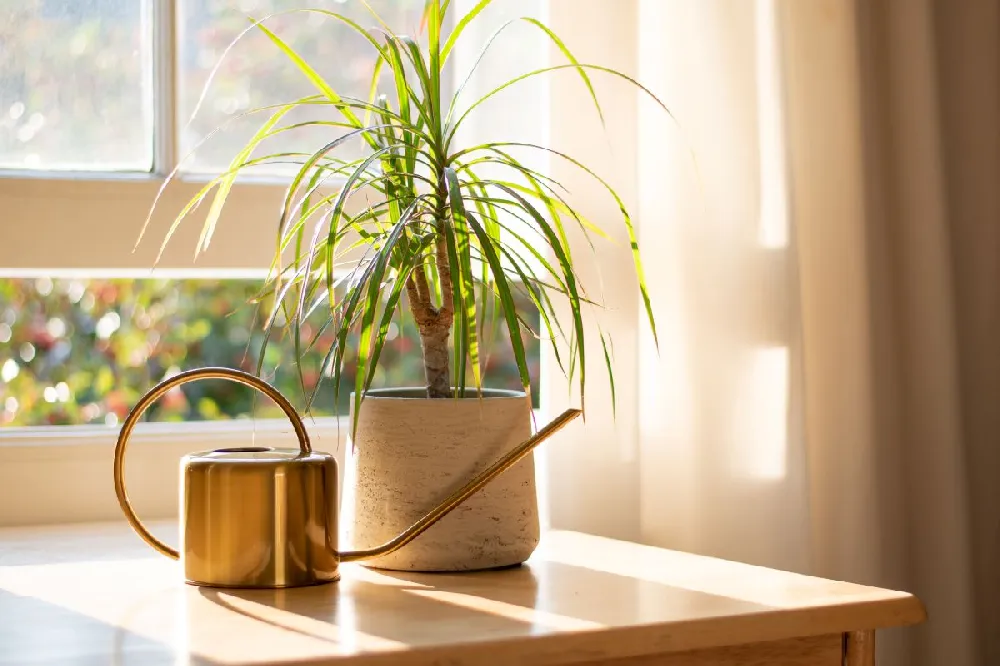- Home >
- Houseplants >
- Braided Madagascar Dragon Trees
Braided Madagascar Dragon Trees for Sale - Buying & Growing Guide
With its distinctive red-tinged leaves and strong constitution, the Madagascar dragon tree, or Dracaena marginata, is popular as a floral adornment in homes and offices. As its name suggests, the Madagascar dragon tree is indeed a native of Madagascar, making it best suited as an indoor plant in North America. Here are some other facts about the Madagascar dragon tree:
- These low-maintenance plants can withstand a fair amount of neglect.
- Madagascar dragon trees typically have long lifespans.
- For an even more compelling visual element, the tree’s slender stems can be braided together.
Enter your zip code to find nearby stores that may carry this plant.
Plant Care
Sunlight

Enjoys a moderate amount of light. When indoors, the light should be indirect.
Watering
Water about once every three weeks. In areas of higher light exposure, consider increasing watering frequency.
Fertilizing

Apply a water-soluble fertilizer about three or four times during the growing season.
Planting and Care
Planting instructions
Because Madagascar dragon trees grow best in temperatures between 65 to 80 degrees Fahrenheit, in North America they are typically planted in pots and kept indoors. For the best results, pot them in a loamy, well-draining soil mixed with peat moss. Madagascar dragon trees have extensive root systems, so be sure to choose a pot that gives the plant room to expand. Place the tree where it will receive moderate, indirect sunlight. Too much direct sunlight can scorch the tree’s leaves, while too little sunlight will inhibit growth.
Watering and nutrients
Because of their extensive root systems, Madagascar dragon trees are relatively tolerant of dry conditions. During the growing season, water your tree by moistening the soil evenly when the top 1 to 2 inches of soil is dry. Depending on the amount of light the plant receives, this can mean watering it every 2 to 3 weeks. Use distilled water instead of tap water since common additives such as fluoride can lead to discoloration. Fertilize your dragon tree with a controlled-release fertilizer in the spring and as needed during the growing season. These trees don’t need fertilizing during the fall and winter.
Pruning
Madagascar dragon trees typically do not need much in the way of pruning. You can remove old, dead leaves by hand, or with a pair of scissors or shears. These trees can grow quite tall, so you may want to prune it for size. To shorten the tree, cut the main stems as far back as necessary to achieve the desired height. The cut end should start to show new growth in one to two months. Any type of large-scale pruning like this should be done in early spring before the growing season starts.
Pests and diseases
These plants are usually disease resistant, although overwatering can cause the stem to rot. Spider mites and mealybugs are the most common pests that bother Madagascar dragon trees. Mealybugs leave small, sticky cotton deposits on plant leaves, while spider mites leave brown spots and webbing. If you notice any signs of infestation, it’s best to treat your plant right away by coating the leaves completely with neem oil or insecticidal soap. If possible, move the plant outdoors while treating the infestation.
Lighting
Moderate indirect light is best for the Madagascar dragon tree. It will enjoy living in some shade, as long as it isn’t too dark. If the plant doesn’t get enough light, then newly grown leaves will be smaller and sickly looking. The opposite, too much light, is equally problematic, with direct light scorching the leaves.
Keep the plant away from any windows that receive a lot of sunlight, or if you must keep the plant on a windowsill, then filter the light with blinds or thin panels of fabric.
Temperature
The Madagascar dragon tree likes similar temperatures to humans, meaning if you’re comfortable in your home, then your plant will be too. The ideal temperature range for this plant is 60-75 degrees Fahrenheit, though it can just about tolerate temperatures as low as 50 degrees Fahrenheit. Anything below 50 degrees Fahrenheit will result in a very unhealthy plant, so if you have put your Dragon Tree outside for the summer, then it must be brought back inside before temperatures drop too low.
Due to this plant enjoying the warmth, it’s best to home it in a room you commonly spend time in. If you place it in a rarely used rec room or guest bedroom that doesn’t often have the heat turned on, then it may get too chilly in the winter and start to lose leaves. Similarly, if you live in s colder climate and go away for any length of time during the winter, then you’ll need to set the heating on a timer so that your plant doesn’t die of cold while you’re gone.
The fact that the Madagascar dragon tree enjoys a similar temperature to people is another element that makes it a good houseplant, as little thought needs to go into keeping the plant well.
Humidity
The average humidity found in homes is suitable for this plant, though particularly dry air might be an issue. To combat this, mist the plant occasionally with a fine water spray. This will help to increase the humidity around the plant, and it also helps to reduce the buildup of dust that can sometimes affect the leaves. As well as looking unappealing, the dust buildup is a common problem for this type of plant, as the dust layer prevents light from getting to the leaves, effectively putting the plant into a heavy shade.
Repotting
This plant will grow in accordance with the size of its pot, so repot this plant with caution if you do not want a tall tree taking over your living room. With many houseplants, repotting is essential for the health of the plant, as it will start to show symptoms of becoming unwell when the roots become pot-bound. This is not so much the case for the Madagascar Dragon Tree, and it will do quite well in a pot that has become saturated with root growth.
Younger Dragon Trees will need repotting every two or years while they are growing, though never go more than one or two sizes up in one move. Once the plant has reached a height you are happy with, discontinue your repotting schedule, and instead, just change the soil annually. This will both freshen up the nutrients in the pot, and also prevent the soil from becoming too compacted over time, which can create a drainage issue.
Madagascar dragon trees do quite well with little space for their roots, so repotting is rarely a pressing issue for this plant. The only reason you may need to repot an older plant, in spite of not wanting it to gain any more height, is if it starts to suffer as a consequence of being in a small pot.
Propagation
There are several different ways to propagate a Madagascar dragon tree, all of which usually have good levels of success.
To propagate with a stem cutting, cut the crown and a few inches of stem from the top of your mature plant, and plant this up in fresh soil. Rooting hormone can be used on the base of the stem cutting to encourage root growth, though this is not usually necessary, and propagation of this plant is generally successful without rooting hormone. Your planter cutting will need to be heated from underneath. If this isn’t possible, be sure to only attempt propagation during warm summer months when the cutting will naturally benefit from heat.
After you have cut off the top of a stem from the mother plant, at least two new stems, though often several, will grow from the cut end. At this point, you can decide whether you’d like to allow them to continue growing on your plant, or if you want to propagate more to make several Madagascar dragon trees. To propagate these new stems, cut them off at their base once they are a few inches long, and simply pot them into soil. Keep the soil moist but be sure not to overwater. As an alternative to soil, you could also propagate the cuttings in water, which is a good way to keep track of new root growth visually.
Common Problems
Small leaves
If the new growth on your Madagascar dragon tree comes in the form of small leaves, the problem is almost certainly too little light. Moving the plant to a brighter spot, though still away from direct light, should fix the issue.
Dropping leaves
It can be quite alarming when your plant starts to lose its leaves, but as long as they are dropping from the underneath over the space of a few weeks, then it isn’t a cause for concern. New leaves grow from the crown at the top of each stem, and older leaves on the underneath fall off to make space for new growth. If your plant is still growing new leaves at the top, then falling leaves at the bottom are a perfectly normal part of the plant’s cycle. They often turn a yellow color before they fall, and again, this is normal, provided it is only happening to the underneath leaves as new growth happens above.
If yellowing leaves are dropping from all over the plant, then this could indicate a problem. Check the stem to see how firm it feels. A healthy plant will have a firm stem, while a squishy stem needs to be addressed
Soft stem
A squishy stem is usually the result of prolonged overwatering, or in some instances can also be caused by very low temperatures. A squishy stem can rarely be saved as the damage inflicted on the plant runs too deep. However, if there are any firm spots on the stem, or if the crown still feels firm, then you can cut these parts and propagate them to grow a new plant from the remains of the old one.
Brown-spotted leaves
Brown spots on leaves are a symptom of the plant not getting enough water. It’s important to distinguish whether the brown marks are spots or blotches, because blotchy looking brown marks are caused by the opposite problem: overwatering. Identifying your issue and remedying it with either more or less water should resolve the problem.
Brown-tipped leaves
The tips of the leaves turn brown usually as a result of cold draughts getting to the plant. Another symptom of this can be the edges of the leaves turning yellow and thin. Remove any damaged parts of leaves and relocate the plant to a more appropriate place, away from windows or doors where cold draughts can occur. The plant should recover well when in better conditions.
Pale leaves
Pale or bleached leaves are the result of too much light. Direct light will scorch the leaves and lead to discoloration. Keep the plant in a bright spot away from indirect light, or, alternatively, in a spot with some occasional shade.
FAQs
Are Madagascar dragon trees toxic?
While Madagascar dragon trees do not pose any threat to humans, they are poisonous for common household pets, like dogs and cats. The tree’s leaves contain toxic alkyds, which are harmful to pets if ingested. Signs of pet poisoning from a Madagascar dragon tree include vomiting and excessive salivation. If you have pets, place your Madagascar dragon tree in a location where your pets cannot access it
Can you grow Madagascar dragon trees outdoors?
As natives of tropical environments, Madagascar dragon trees thrive in temperatures between 65 and 80 degrees Fahrenheit, and cannot tolerate below-freezing temperatures. If you live in a USDA hardiness zone 10-12, you should be able to successfully grow a Madagascar dragon tree outdoors. These trees are sensitive to temperature, so even if you have your plant indoors, make sure it is in a well-heated room, away from drafty windows, especially during the winter months.
How do you propagate a Madagascar dragon tree?
The most common propagation method for Madagascar dragon trees is with stem cutting. Cut the crown and a few inches of stem from the top of a mature plant and plant in fresh soil. You can apply rooting hormone to the base of the stem prior to sticking the cutting in soil, although this isn’t required. For best results, propagate in the warm summer months or place the new plant over a gentle heat source to encourage growth.
How large do Madagascar dragon trees grow?
This depends on the tree’s location. Outdoors, full-grown Madagascar dragon trees can reach 15 to 20 feet in height with a spread of up to 10 feet. Indoors, they are much smaller, although they can still reach about 6 feet in height if growth is left unchecked. Regular pruning will help keep your tree at a manageable size. These plants are relatively slow-growing, so they won’t reach their full size for several years.
Are there different varieties of Madagascar dragon tree?
Yes. There are several different varieties of the Madagascar dragon tree. The basic variety is Dracaena marginata, which has dark green leaves and thin red margins. Other popular varieties include D. marginata ‘Tricolor,’ which have green leaves with dark red margins and an ivory strip in the leaf’s center; D. marginata ‘Bicolor,’ which have red- and green-striped leaves; and D. marginata ‘Colorama,’ which are nearly completely pink, with white and green stripes.
